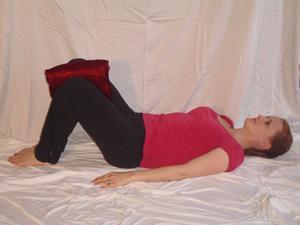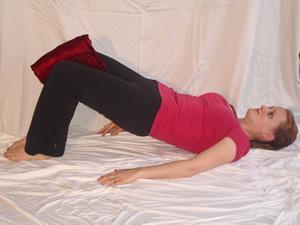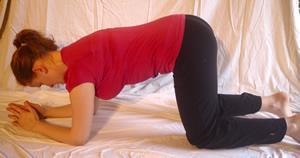
“I do Kegels, but they don’t work”
International Journal of Childbirth Education, June 2009
Heather Jeffcoat, DPT
Post-partum urinary incontinence is a common problem. But is it normal to experience urinary incontinence after you’ve delivered a baby?
There is a typical history I encounter in my practice—“I’ve had two kids and now whenever I laugh or sneeze, I experience urine leakage”. But it’s normal, right? I always tell my clients that the problem may have arisen because of childbirth, and maybe all of their friends giggle about this unfortunate consequence of having a beautiful and perfect baby. But it is not NORMAL—there is something you can do (other than surgery or medication) to get your pelvic floor muscle function back to normal. And it’s more than doing just Kegels.
I’ve had many women tell me over the years, “I do Kegels, but they don’t work”. A study published in The American Journal of Obstetrics and Gynecology (Bump, et al 1991) looked at the performance of Kegel exercises after brief verbal instruction. The results showed that 51% of women were performing a Kegel incorrectly at this level of teaching. Worse yet, 25% of women were performing them in such a way that could actually worsen their incontinence. This study highlights the principal that if an exercise is not performed properly, it will not work and has the potential to worsen the problem.
The first item to consider is, does your client perform a Kegel properly? This is an essential first step in reducing or eliminating incontinence. Here is a helpful trick your clients can try at home: Take a mirror to visualize the perineal area. When performing a Kegel, they should only see the anus and vaginal opening lift and close. They should not see or feel the muscles in their inner thighs or gluteal area contract or their abdominal muscles bulge out. This technique acts as a form of home biofeedback to train the proper muscle contraction.
Once your client is able to isolate a Kegel, a progressive strengthening program comes next. How many should they do? What type of Kegel? This question is always followed with “There is more than one kind of Kegel??” When in doubt, start with a program that’s too easy rather than too difficult.
Sample Kegel Progression:
- Week 1: Hold 1 second (“Quick Flick”). Perform 2 sets of 5, 3 times per day.
- Week 2: Increase to 2 sets of 10, 2 times per day.
- Week 3: Increase to 2 sets of 15, 1 time per day.
- Week 4: Continue with Week 3 routine, add 3 second holds (“Long Holds”), 2 sets of 5.
Continue to increase 3 second holds per Week 2 & 3 protocol. Once, up to 2 sets of 15, increase hold times to 5 seconds and reduce repetitions to 2 sets of 5 again. Continue to gradually increase repetitions. Your client’s goal will be to perform “Long Holds” for 10 seconds, at least 2 sets of 10 daily.
![]()

![]()

Sidelying Hip Abduction with Hip External Rotation: Instruct your client to lie as pictured above, with the top hip turned out slightly (so that the toes point towards the ceiling). Note, each hip should be stacked one on top of the other, with no rotation of the spine present.
Prone Diamonds:
Instruct your client to lie on her stomach as pictured above. Cue her to exhale as she lifts her thighs up off the floor, pushing her pubic bone down.

It should be noted that any position or movement that causes a client to hold her breathe is too strenuous. This will increase intraabdominal pressure and place undue strain upon the abdominal wall and pelvic floor muscles. If abdominal bulging is observed through a separated rectus abdominus (if present), the exercise being performed is likely too difficult and should be modified or discontinued if a modification is not possible.
Don’t forget the valuable input of a Women’s Health Physical Therapist (now often referred to as a Pelvic Floor Physical Therapist or Pelvic Health Physical Therapist), which can assist you with finding other potential causes of incontinence and provide a more directed treatment plan. If you don’t know of one in your area, you can contact the Academy of Pelvic Health Physical Therapy or schedule with us at one of our Los Angeles offices.
We are here to support you with your postpartum urinary incontinence, bladder leakage and other pelvic health and orthopedic needs!
References:
Bump, et al. Assessment of Kegel pelvic muscle exercise performance after brief verbal instruction. Am J Obstet Gynecol. 1991 Aug;165(2):322-7
Carriere, B., Feldt, C.M. 2002. The Pelvic Floor. New York: Thieme.
Di Benedetto, P., Coidessa, A., Floris, S. Rationale of pelvic floor muscles training in women with urinary incontinence. Minerva Ginecol. 2008 Dec;60(6):529-41.
Hay-Smith, E.J., Dumoulin, C. Pelvic floor muscle training versus no treatment, or inactive control treatments, for urinary incontinence in women. Cochrane Database Syst Rev. 2006 Jan 25;(1):CD005654.
Stephenson, R., O’Connor, L. 2000. Obstetric and Gynecologic Care in Physical Therapy. New Jersey: Slack, Inc.
